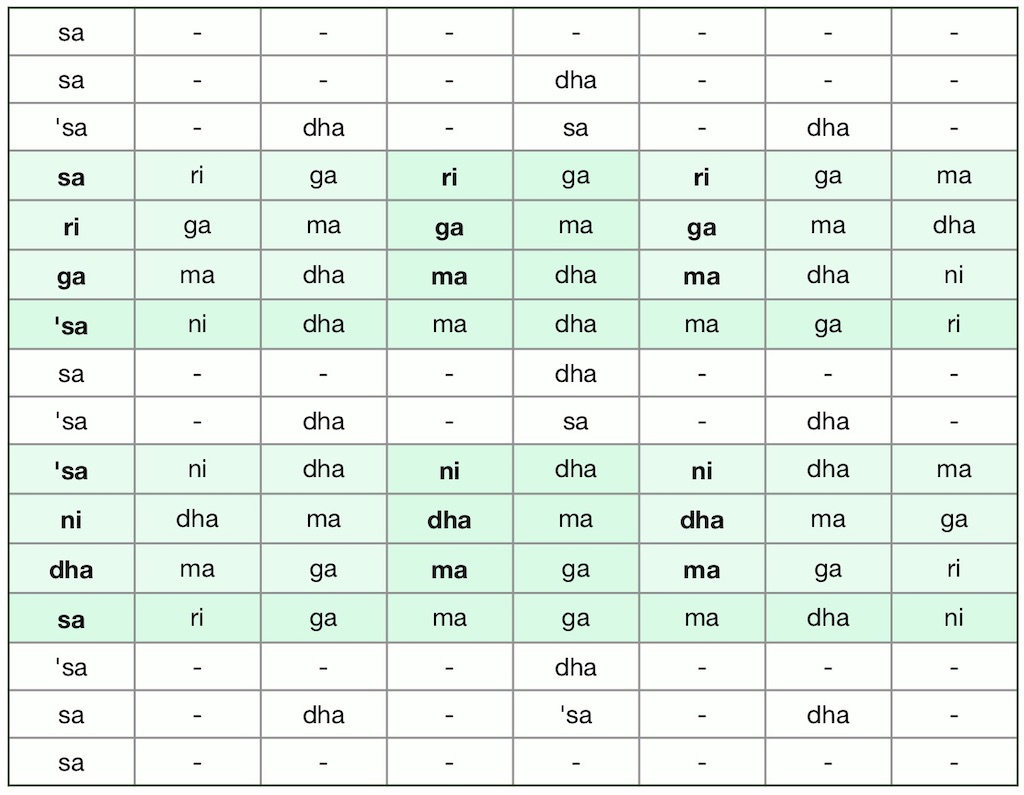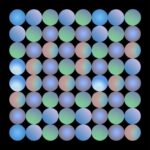
Listen to a kriti (2nd item) sung by Bhushany Kalyanaraman >>
Explore other renditions of raga Sriranjani and raga Hamsanandi on YouTube >>
Find song lyrics (composers) & translations for these and other ragas >
“Flow” exercises
A series of “Flow” exercises invites learners to practice all the 72 musical scales of Carnatic music (“mela” or mēlakarta rāga). It is meant to supplement the comprehensive standard syllabus (abhyāsa gānam) attributed to 16th c. composer Purandara Dasa.
Repeated practice need not be tedious; instead it instantly turns joyful whenever we remind ourselves that Indian music “is created only when life is attuned to a single tune and a single time beat. Music is born only where the strings of the heart are not out of tune.” – Mahatma Gandhi on his love for music >>
As regards “time beat” in Carnatic music, the key concept is known as kāla pramānam: the right tempo which, once chosen, remains even (until the piece is concluded). | Learn more >>
Music teachers will find it easy to create their own versions: exercises that make such practice more enjoyable. | Janta variations >>
Concept & images © Ludwig Pesch | Feel free to share in accordance with the
Creative Commons Attribution-NonCommercial-ShareAlike license >>
Listen to Uma Ramasubramaniam demonstrating the svaras (notes) for the present raga(s) on Raga Surabhi >>
Note: this recording has no fifth note “Pa”
(as advised for those janya ragas wherein “Pa” will not be sung or played)
Download this audio file (2 MB, 2 min. mono)
Credit: eSWAR / FS-3C Sruthi petti + Tanjore Tambura
Become fluent with the help of svara syllables (solmisation): practice a series of exercises, each based on a set of melodic figures that lend themselves to frequent repetition (“getting into flow”) | Practice goal, choosing your vocal range & more tips >>
South Indian conventions (raga names & svara notation): karnATik.com | Guide >>
raagam: hamsAnandi
Aa: S R1 G3 M2 D2 N3 S | Av: S N3 D2 M2 G3 R1 S
raagam: shrIranjani
Aa: S R2 G2 M1 D2 N2 S | Av: S N2 D2 M1 G2 R2 S
Having but 6 notes (instead of 7), this type of raga pattern is traditionally classified as being “derived” (janya) from a melakarta raga. More specifically, text books refer to any raga limited to 6 notes as shadava raga.
The most characteristic feature in the above svara pattern is the absence of the fifth note (pa) – the very note that conveys a sense of balance in most other ragas. It may be sung, hummed or practiced silently with any sadava–sadava raga you are already familiar with (e.g. Sriranjani and Hamsanandi).

Once internalized you may want to contemplate and remember the same exercise with the help of the “8 x 8 beads” pattern shared here>>
Listen to a brief excerpt of a sloka in raga Hamsanandi sung by Aruna Sairam (Padam le chant de Tanjore, Ocora, Radio France, 1999)
Up-to-date press coverage of person and topics
Periodicals and sites included | More resources | Disclaimer >>
Please note that the above figures lend themselves to several “Carnatic sister ragas”.
So try and follow the same exercise with the proper notes associated with these janya ragas (carefully avoiding the 5th note, pa):
- Bhavani (derived from the 44th melakarta raga, Bhavapriya)
- Hamsanandi (derived from the 53th melakarta raga, Gamanasrama)
- Lalita (derived from the 15th melakarta raga, Mayamalavagaula, for some composers from the 17th melakarta raga, Suryakanta)
- Ravicandrika (derived from the 28th melakarta raga, Harikambhoji, and in compositions distinguished by the vakra “zigzag” pattern ni-dha-‘sa heard in the ascending series)
- Sriranjani (derived from the 22nd melakarta raga, Kharaharapriya)
- Suddha Todi (derived from the 8th melakarta raga, Hanumatodi)
Learn more and download a free mela-pocket guide here: Boggle Your Mind with Mela (BYMM) method – free mini course >>
